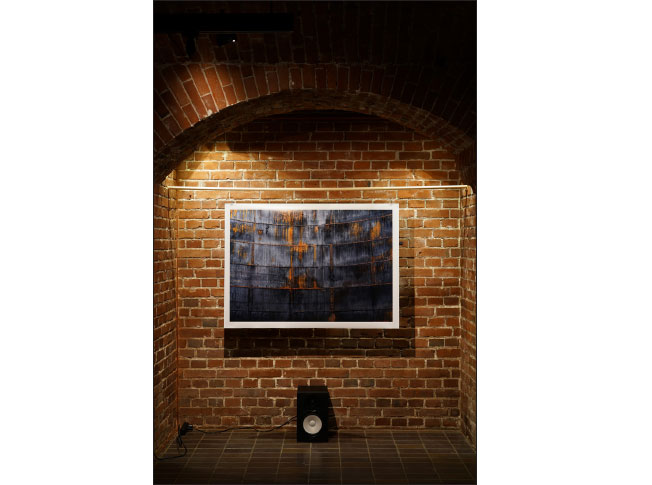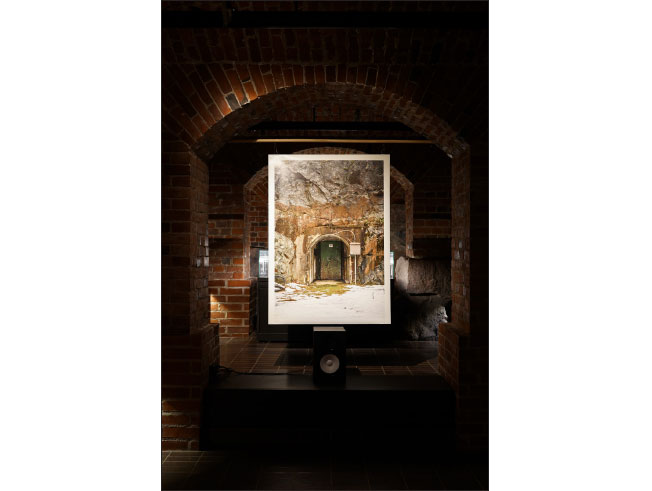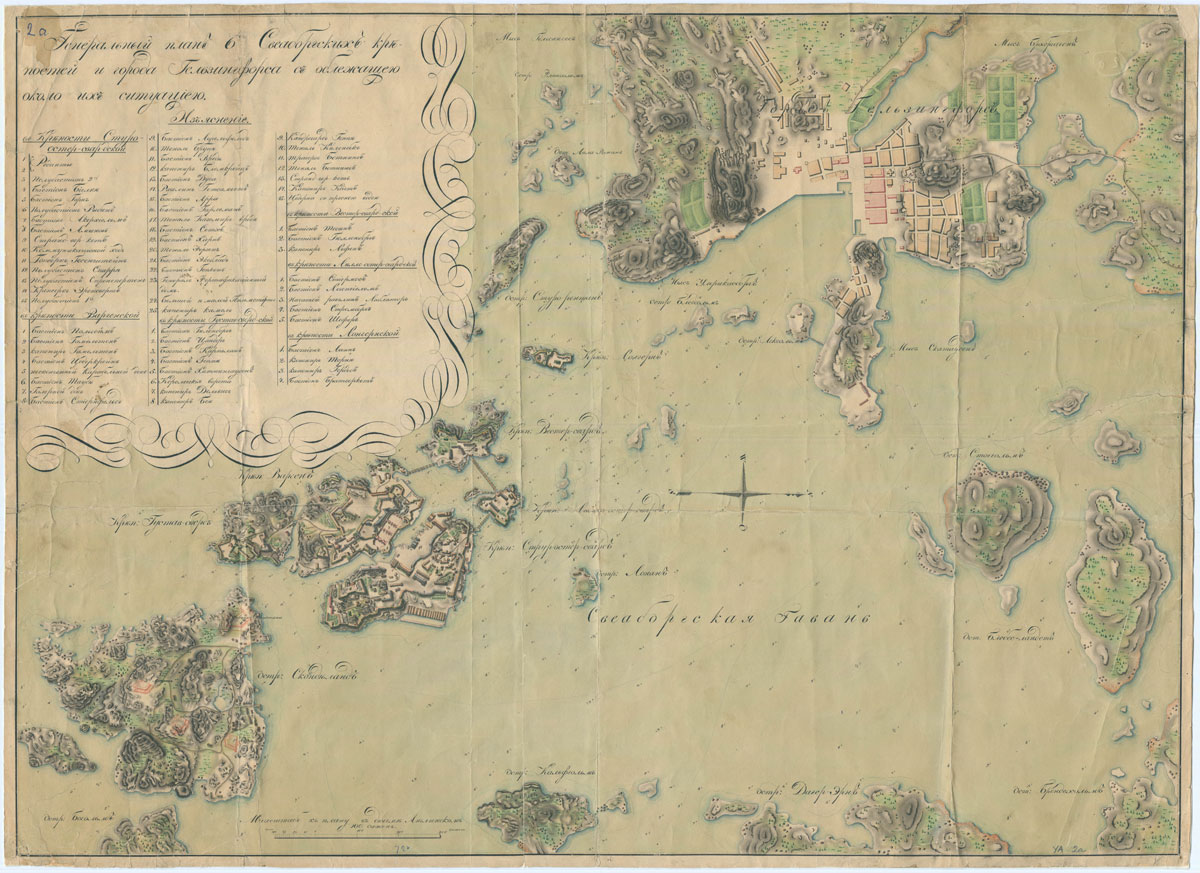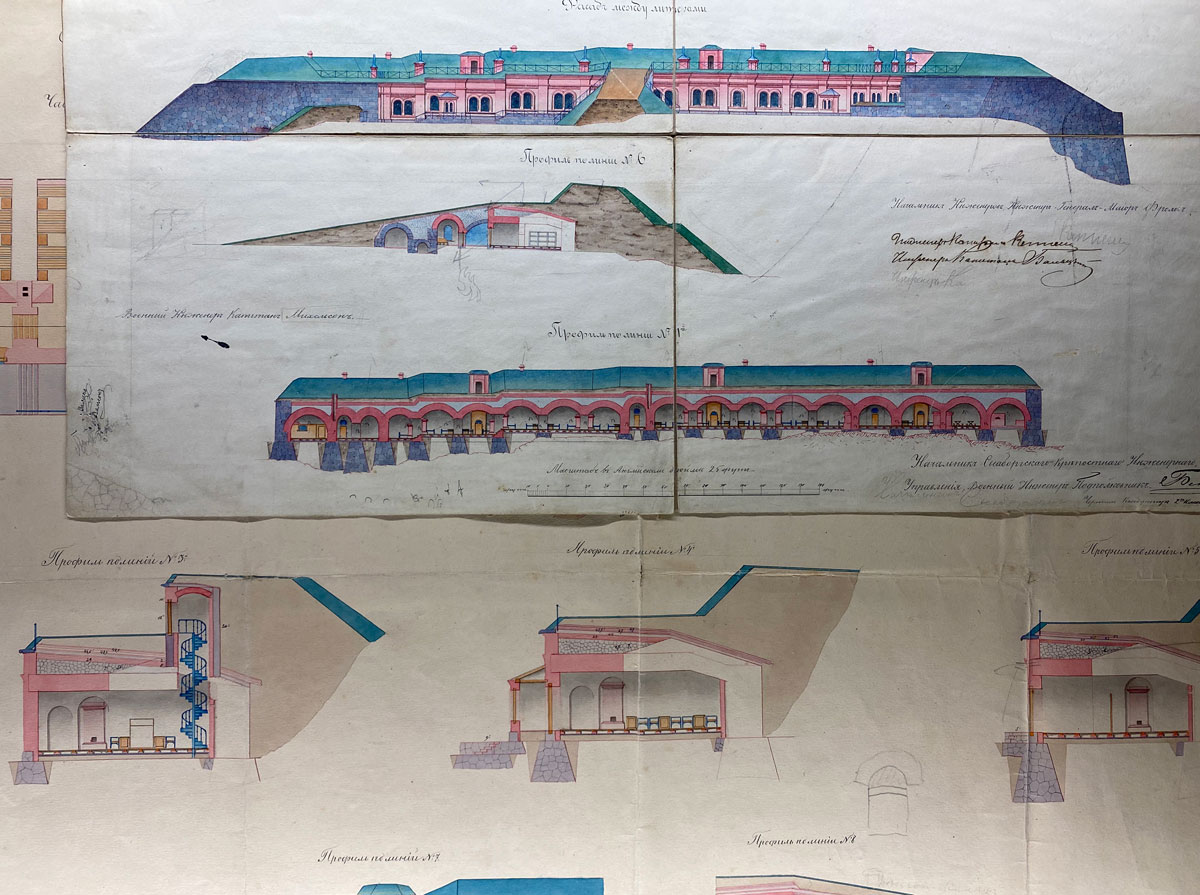The curators of the exhibition Instruments of Occupation requested silence as we moved on its opening night from the grand neoclassical foyer of the National Archives of Finland into a dark low-ceilinged brick crypt. That serious quiet was uncomfortable, but the reward was nearly immediate. In the passageway that linked the haptically incongruous spaces, the first soundscape reached the ear: a delicate tinkle of ice floes hitting a Gulf of Finland shoreline.
As our ears adjusted to silence, our eyes adjusted to low light. Straight ahead, beyond a tunnel of darkness, the first of eight large-scale “slow” photographs by Dan Dubowitz hung in shallow brick archways, while speakers sat on the floor beneath (Figures 1–2). A high-resolution image of a rusting oil tank—an abstract close-up in blue and orange—was accompanied by an audio installation crafted from site recordings by composer Tuomas Toivonen. Toivonen had turned the tank into a drum. He generated resonant thuds by banging its side; at the same time, his microphone captured the cracking of sporadic rifle fire from a garrison in the distance. Behind the photographs, on an elevated plinth, were 11 glowing vitrines filled with exquisite 19th-century drawings, curated from the National Archives of Finland by Markus Lähteenmäki, of military installations by the Russian army engineering corps and of neoclassical Russian imperial administrative buildings in Helsinki and beyond designed by the architect Carl Ludvig Engel. These three artistic modes—photography, sound, and drawing—created the conditions for an immersive encounter with the “accidental monuments” of Russian imperial occupation and control on the archipelago of Helsinki.
The curator-creators explained at the exhibit’s opening that when they started, they had been unsure what shape their collaboration would take. They had begun by simply taking boat trips out to the islands during the bleak winter months to explore and seek inspiration from the mute imperial objects they encountered. On one of their first trips to Vasikkasaari island, Toivonen picked up a large stone and struck the oil tank featured in Dubowitz’s opening photograph. Its boom and minute-long resonance led to the curators’ deepest insight: that the objects they encountered were instruments that needed to be played and interacted with. As Dubowitz, Toivonen, and Lähteenmäki walked through the snow, making tracks on these eruptions of stone and earth in the gulf, they found themselves participating in the incremental change of these places. The exhibit was framed as a provisional first attempt to share the visual and aural results of their improvisational, speculative, and inscriptive modes of research.
The exhibit was an unusual opening keynote for the European Architectural History Network “States in Between: Empire and Architecture in East Europe and North Eurasia” conference, convened in Helsinki in early June 2023. Scholars of these territories were asked to rethink “the practices of colonialism, empire-building, and center-periphery relations” and to pose “questions about national identity and built heritage in Eastern Europe and Northern Eurasia.” The precipitating event for this reevaluation of the field is the ongoing war of aggression by Russia on Ukraine, which began in 2014 with the illegal annexation of Crimea and portions of eastern Ukraine and escalated horrifically in February 2022.
The territories addressed in the scholarly papers, which ranged from Berlin to Buryatia, were conceptualized as “in-between” states for the conference, that is, places whose built environments had been strewn with the detritus left by external actors who moved through, decamped, and/or remotely controlled them (Mrduljas 2012). The sites discussed in the papers and featured in the exhibit fall in the long shadow cast by particularly acquisitive and violent regimes that handed the baton from one to the next, namely the Russian imperial and Soviet systems. It is fair to say that the present political regime in the Russian Federation understands itself to be the latest recipient of that baton. Russia’s unprovoked attack on Ukrainian sovereignty only serves to amplify the unsettled nature of spatial occupation in these states in between.
The heavy materiality of the architecture that enclosed the exhibit, composed of thick structural brick piers that the visitor had to move around and between, was a reminder of the persistence of empire’s remainders that often long outlive the political authority that constructed them (Figure 3). At certain moments the piers in the archive’s cellar aligned and offered enfilade views, but overall, the exhibit space was appropriately oppressive. The topographical surveys and designs for defensive structures and monumental buildings represented in the archival drawings—structures and buildings whose purpose was to serve remote power in St. Petersburg—were likewise contained and controlled, situated as they were within the lighted vitrines that illuminated visitors’ bowed faces (Figures 4–5). As Lähteenmäki observed, the mode of orthographic projection differed for each type of imperial installation: large-scale surveys of the archipelago were rendered solely in plan; middle-scale engineering drawings that meticulously calculated the cut and fill of island soil, information that was needed to construct fortifications, were almost exclusively sections; and the representational buildings in the city were drawn in elevation. These descriptive choices map onto the various scales and modes of control imposed on greater Helsinki during Russian imperial rule.
Instruments of Occupation exhibit walk-through on opening night, 7 June 2023. Video by Dan Dubowitz, 2023.
Map of Helsinki, the Sveaborg fortress, and the surrounding islands by the Russian Engineering Corps at the time of Russian takeover, ca. 1810s, VESA YA:0002a, National Archives of Finland. https://astia.narc.fi/uusiastia/viewer/?fileId=5946999666&aineistoId=2493708018.
The setup of the exhibit did feel provisional, perhaps by design. In a polished show the speakers might have been hidden and the photos hung with fasteners more sophisticated than binder clips. The curators also elected not to include labels with the works, relying instead on a triple-folded A3 pamphlet to guide visitors through the content of the show. Trying to read explanatory texts as we fumbled in the dark with the folded sheet was difficult. Nevertheless, the decision was probably the correct one. I eventually stopped trying to read the sheet and instead engaged in close looking and listening, which rendered the exhibit a more affecting experience.
The National Archives of Finland bent its rules to allow the invaluable archival drawings to be moved to the basement exhibition space. Tight security was an understandable consequence and so there were only four closely overseen public viewing opportunities. It was an exhibit that would have benefited a larger number of Helsinkians since, as Lähteenmäki explained, only through this experimental co-curatorial project did he come to grasp that his native city could not be understood without the defensive archipelago that justified its location and vice versa.
The late Polish art historian Piotr Piotrowski, the conference’s oft-cited intellectual muse, provides a way to theoretically frame the work of both the exhibit and the scholarly presentations in his 2014 essay titled “East European Art Peripheries Facing Post-Colonial Theory” that was published shortly before his death. In it, he asks whether postcolonial discourse can be fruitfully applied to Eastern Europe and determines it cannot. More recently in the context of the war, Ukrainian art historian Svitlana Biedarieva has argued that in fact “both the post-socialist and post-colonial conditions gradually evaporated from the territory of Ukraine after 2014” (2022). Piotrowski’s counter proposal to the idea of applying postcolonial methodology in East European/Eurasian contexts is to enact “horizontal” critical art geography, a mode of historical practice that refuses a center-periphery binary and that is deeply rooted in place. “The crucial approach,” he suggests, “seems to be both to understand geography though the question of a place … and to historicize it in order to get a dynamic structure between the place and time, geography, or even topography so to speak, and history” (2014). Enacting horizontal historiographical practice in the context of architecture requires being on the ground, situating structures and their architects in a specific political, cultural, social (and so on) context. Most importantly, in horizontal history, the center shifts to wherever the work is, and the horizon line of this perspective is the eye level of the historical protagonists. In this spirit, Instruments of Occupation occupied the ground of the former occupiers, inscribed the site with tracks, reconstructed the conditions of the objects’ emergence, tracked their traces in official documentation, and captured them diachronically and synchronically, as Piotrowski recommends. In other words, the exhibit unabashedly centered the Helsinki archipelago, situating it within a new category of postness: the postperipheral.
Competing Interests
The author was a member of the Scientific Committee of the European Architectural History Network Thematic Conference ‘States in Between: Empire and Architecture in East Europe and North Eurasia’ in June 2023. Piotrowski’s essay was published in nonsite.org, the journal published by the Emory University Art History Department, the author’s institutional home.
References
Biedarieva, S. 2022. Decolonization and Disentanglement in Ukrainian Art. post MoMA. Available at https://post.moma.org/decolonization-and-disentanglement-in-ukrainian-art/ [last accessed 20 June 2023].
Mrduljas, M, Kulić, V and Thaler, W. 2012. Modernism In-Between: The Mediatory Architectures of Socialist Yugoslavia. Berlin: Jovis.
Piotrowski, P. 2014. East European Art Peripheries Facing Post-Colonial Theory. nonsite.org. Available at https://nonsite.org/east-european-art-peripheries-facing-post-colonial-theory [last accessed 20 June 2023].



